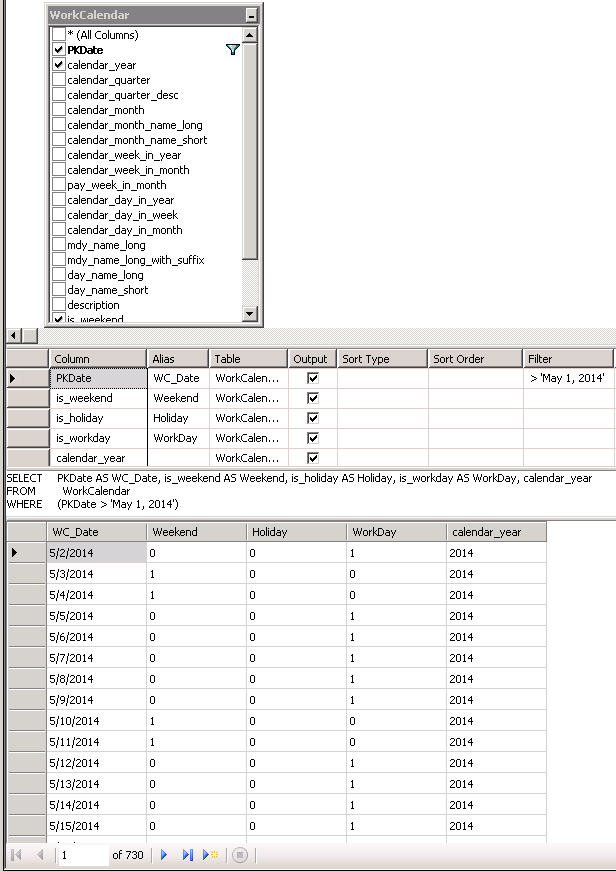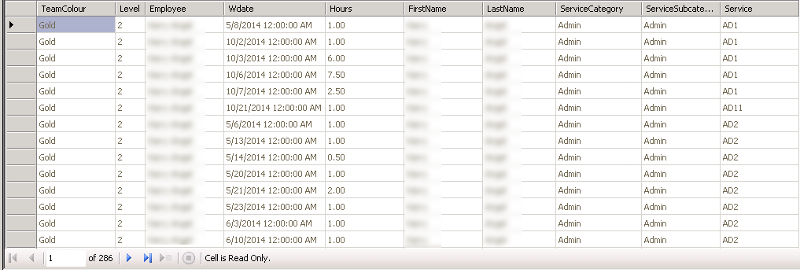Need help recreating an excel lieu time sheet in SSRS
I'm trying to recreate a lieu time report currently in excel. I have a table storing hours entered, the code (billable, personal, vacation, etc.) against which it is entered, the date and the employee id. I can easily pull out all the data for a given employee beginning with the start of our fiscal year (May 1) but I'm not sure about how to group it by the week ending. Plus I have a separate table where I've generated all the days of the year and marked it as either a work day, weekend or holiday (as well as other information).
This is the sheet I'm trying to recreate:

And here is the code I used to create the calendar table (I didn't include the last part where I mark the holidays). Though I think perhaps I should have included the week ending day.
I am not sure how to generate this report. Should it be a Matrix with the codes at the top? Should I group codes together in the ds query, such as the PE3 and PE6 Personal Time? Perhaps I need the initial query to return results for each week with grouped codes?
Any suggestions on how to get this up and running would be greatly appreciated!!!
This is the sheet I'm trying to recreate:

And here is the code I used to create the calendar table (I didn't include the last part where I mark the holidays). Though I think perhaps I should have included the week ending day.
IF EXISTS(SELECT * FROM sys.tables WHERE name='WorkCalendar')
DROP TABLE WorkCalendar
GO
CREATE TABLE WorkCalendar (
PKDate date primary key,
-- Years
calendar_year smallint,
-- Quarters
calendar_quarter tinyint,
calendar_quarter_desc varchar(10),
-- Months
calendar_month tinyint,
calendar_month_name_long varchar(30),
calendar_month_name_short varchar(10),
-- Weeks
calendar_week_in_year tinyint,
calendar_week_in_month tinyint,
-- added
pay_week_in_month tinyint,
-- Days
calendar_day_in_year smallint,
calendar_day_in_week tinyint, -- The first of the month
calendar_day_in_month tinyint,
mdy_name_long varchar(30),
mdy_name_long_with_suffix varchar(30),
day_name_long varchar(10),
day_name_short varchar(10),
description varchar(30),
is_weekend tinyint, -- Tinyint and not bit so you can add the 1's.
is_holiday tinyint, -- Tinyint and not bit so you can add the 1's.
is_workday tinyint, -- Tinyint and not bit so you can add the 1's.
is_event tinyint -- Used to indicate any special event days.
)
;
DECLARE @dt_start date = '20120101'
, @dt_end date = '20160430'
, @total_days int
, @i int = 0
, @start_Month int = 5 -- added
SELECT @total_days = DATEDIFF(d, @dt_start, @dt_end)
WHILE @i <= @total_days
begin
INSERT INTO WorkCalendar (PKDate)
SELECT CAST(DATEADD(d, @i, @dt_start) as DATE)
SET @i = @i + 1
end
;
UPDATE WorkCalendar
SET
calendar_year = YEAR(PKDate),
calendar_quarter = DATEPART(q, PKDate),
calendar_month = DATEPART(m, PKDate),
calendar_week_in_year = DATEPART(WK, PKDate),
calendar_day_in_year = DATEPART(dy, PKDate),
calendar_day_in_week = DATEPART(Weekday, PKDate),
calendar_day_in_month = DATEPART(d, PKDate),
day_name_long = datename(weekday, PKDate)
;
UPDATE WorkCalendar
SET
is_weekend = CASE DATEPART(weekday, PKDate) WHEN 1 THEN 1 WHEN 7 THEN 1 ELSE 0 END,
calendar_quarter_desc = 'Q' + CAST(calendar_quarter as char(1)) + ' ' + CAST(calendar_year as char(4)),
calendar_month_name_long = DATENAME(m, PKDate) + ' ' + CAST(calendar_year as CHAR(4)),
mdy_name_long = DATENAME(m, PKDate) + ' ' + CAST(DATEPART( d, PKDate ) as varchar(2)) + ', ' + CAST(calendar_year as CHAR(4)),
day_name_short = LEFT(datename(weekday, PKDate),3)
;
UPDATE WorkCalendar
SET calendar_week_in_month =
CASE
WHEN DATEPART(DAY, PKDate) BETWEEN 1 AND 7 THEN 1
WHEN DATEPART(DAY, PKDate) BETWEEN 8 AND 14 THEN 2
WHEN DATEPART(DAY, PKDate) BETWEEN 15 AND 21 THEN 3
WHEN DATEPART(DAY, PKDate) BETWEEN 22 AND 28 THEN 4
ELSE 5
END
;
-- added
update WorkCalendar
set pay_week_in_month = sq.PAY_WEEK_IN_MONTH
from WorkCalendar
inner join (
SELECT
dense_rank() over (partition by fy_start
, month(paywk_end)
order by paywk_start) as PAY_WEEK_IN_MONTH
, pkdate
FROM WorkCalendar AS cal
cross apply (
/* calc the number of days to reach Saturday of this "week" */
select abs((datediff(day,6,pkdate) % 7) - 6)
) ca1 (to_sat)
cross apply (
select
dateadd(day,-6,dateadd(day,to_sat,pkdate))
, dateadd(day,to_sat,pkdate)
, dateadd(month,@start_month-1,
case when month(pkdate) >= @start_month
then cast(dateadd(year,year(pkdate)-1900,0) as date)
else cast(dateadd(year,year(pkdate)-1901,0) as date)
end)
) ca2 (pay_start,pay_end, fy_start)
cross apply (
select
case when month(pay_start) < @start_Month and
month(pay_end) = @start_Month and
datediff(day,fy_start, pay_end) < 8
then fy_start
else pay_start
end
, case when month(pay_start) < @start_Month and
month(pay_end) = @start_Month and
datediff(day,fy_start, pay_end) > 365
then dateadd(day,-1,dateadd(year,1,fy_start))
else pay_end
end
) ca3 (paywk_start,paywk_end)
WHERE cal.pkdate BETWEEN @dt_start AND @dt_end
) sq on WorkCalendar.pkdate = sq.pkdate
; I am not sure how to generate this report. Should it be a Matrix with the codes at the top? Should I group codes together in the ds query, such as the PE3 and PE6 Personal Time? Perhaps I need the initial query to return results for each week with grouped codes?
Any suggestions on how to get this up and running would be greatly appreciated!!!
Are these tables related? I can see you have a "Week number" in "Work Calendar data", but do you have a date there for the start of the Week? That seems to be the thing you are lacking (unless it is hidden from your screenshots).
It can be added with a little SQL if you haven't got it using the WEEKDAY function. It's easier if you have SQL Server 2008R2 or greater, because then you can use the DATE function, i.e.
DATE(year(MyDate), month(MyDate), day(MyDate) - WEEKDAY(MyDate,2) + 1)
Once that is in place, so do the Matrix, with Service going across, and Week Ending going down.
It can be added with a little SQL if you haven't got it using the WEEKDAY function. It's easier if you have SQL Server 2008R2 or greater, because then you can use the DATE function, i.e.
DATE(year(MyDate), month(MyDate), day(MyDate) - WEEKDAY(MyDate,2) + 1)
Once that is in place, so do the Matrix, with Service going across, and Week Ending going down.
ASKER
No there is no start of the week but should I put a start of the week or end of the week? This was originally set up because I was going to make a report that would show the hours per week of the month so dividing the weeks up where one month ends and another begins was a goal. We are using SQL Server 2008 R2 so I can add that column to the table. I'm just not sure how to get the rows to group by week. Does this have to be done in the query or can it be done in the row groups pane?
ASKER CERTIFIED SOLUTION
membership
This solution is only available to members.
To access this solution, you must be a member of Experts Exchange.
ASKER
Got something working for now but I'll continue to work with it to achieve the result I want. Thanks for helping me work through this!


I know what you have in Excel, but presumably have you just transferred the Excel table into SQL Server as is, or have you normalised it, or what?
A bit more information there is essential.
I would suggest starting with a Matrix, and then see if there is anything you need to add afterwards (such as Parameters). Start small, and work up.